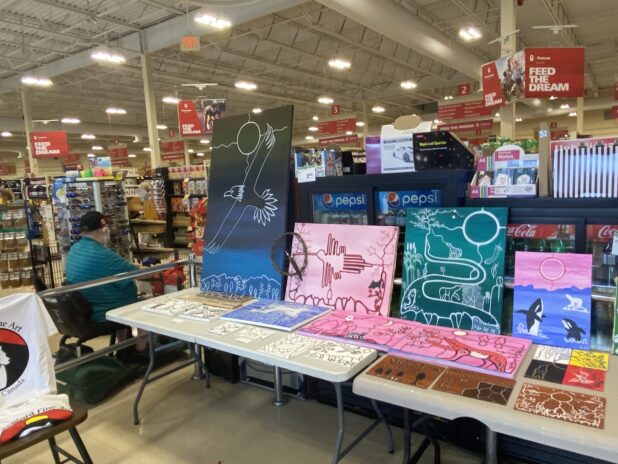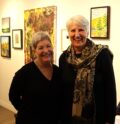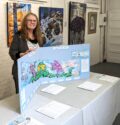Headline News
Algonquin artist ‘Changing Perspectives’ through creation
July 8, 2021

By Nate Smelle
Since the 215 stolen Indigenous children hidden in the soil at the former residential school in Kamloops B.C. were discovered at the end of May, 933 more bodies have been found buried at two other former residential schools (751 near the former Marieval Indian Residential School in Saskatchewan and 182 at the former St. Eugene’s Mission Residential School near Cranbrook, B.C.).
In light of this news, and the fact that there are still more than 100 former residential schools across the country that need to be investigated, this year Canada Day marked a somber occasion for many Canadians coming to terms with the nation’s history of genocide against Indigenous people.
Having just set up a pop-up art exhibit, Changing Perspectives, at Bancroft’s Foodland on June 30, Kijicho Manito Madaouskarini Algonquin artist Sherry Crawford was in town over the Canada Day long weekend to take part in a ceremony at Millennium Park honouring the lives of the stolen Indigenous children who were found and those still who are still missing. Acknowledging how in 2021 Indigenous people across the country are still being forced to deal with the systemic racism that fueled Canada’s murderous residential school system, she said it has been more than 20 years since she celebrated Canada Day.
With the timing of her latest exhibition in Bancroft coinciding with the discovery of the stolen children and Canada Day, Crawford hopes her art will help open people’s eyes to Algonquin culture, and the issues plaguing Indigenous communities. One of the first challenges to overcome before true reconciliation can begin, she said, is figuring out how to awaken Canadians to the true nature of this nation’s history.
“Some people really want to know, and they are really feeling sad; and, then there are other people that are just firing off their fireworks and flying their Canada Day flags,” said Crawford.
“They’re either just oblivious to it, or they simply don’t care. I haven’t celebrated Canada Day for years myself, because I’ve known this stuff for at least 20 years. But, most people are just learning about it. I think about before 20 years ago and ask, ‘where was I?’ My son was five when Oka was happening and I didn’t even know about it. Why didn’t I know about it?”
Recognizing how the mainstream media is just now starting to cover the atrocities that have taken place, as well as those that continue to occur – entire First Nations and Indigenous communities being deprived of clean drinking water for decades, thousands of missing or murdered Indigenous women and girls, Indigenous children being taken from the family and community by Canada’s foster “care” system, homelessness and inadequate housing for Indigenous people to name a few – Crawford sees awareness of these issues beginning to grow. As more non-Indigenous Canadians become aware of how Indigenous people have and are being treated, she expects to see more people pushing for change and an end to these injustices.
“They are not listening to Indigenous people as well as they should be,” said Crawford.
“It will not be until the non-Indigenous people stand up – like the churches – and start writing letters and emails that say ‘why?!’ that there will ever be change. Because we already know we have been crying out for over 150 years, and they aren’t listening to us.”
Crawford continued, “It’s only because the mainstream media has picked it up now. This is not new for us. We have known about these bodies at the schools for years, and we’ve heard that stories from survivors for years. But, now media has decided it’s worthwhile to cover, so I guess they can’t keep it a secret any more.”
Recalling the story of a residential school survivor who watched as the priests loaded the body of one of his friends on a boat to discard of it in the lake, Crawford said even if they uncover the thousands of missing children in the ground they will never know how many were disappeared in the water. As this horrific chain of events continues to unfold, she said the lives of those stolen and killed within Canada’s residential school system must be honoured and celebrated.
“It’s a hard day, because many people want to celebrate Canada Day,” Crawford said.
“They still have that need to share that celebration, so I am going to celebrate too. But, I am going to celebrate that we found the children, and that their voices are being heard. I’m celebrating that Canadians are waking up, and I am celebrating that main stream media is reporting this and getting the truth out there. These are the things that I am celebrating. But, we will never forget what happened, and we will never move forward until people start to accept the truth and realize that it was genocide; and that the oppression still continues today.”
Dealing with issues such as the climate crisis, and the sacredness of land, water, air and all living things, Crawford’s work inspires the admirer to contemplate where they, as an individual and as part of a community, fit into the Creator’s big picture. In addition to Crawford’s paintings, the show also features a colouring book created by the artist, that approaches the same issues from another perspective.
For those interested in experiencing a taste of Algonquin culture through art, Crawford’s Changing Perspectives exhibition will be on display at Foodland until Aug. 1. To learn more about Crawford and view some of her work, visit her website at: www.jamesfineartcollection.com.

















